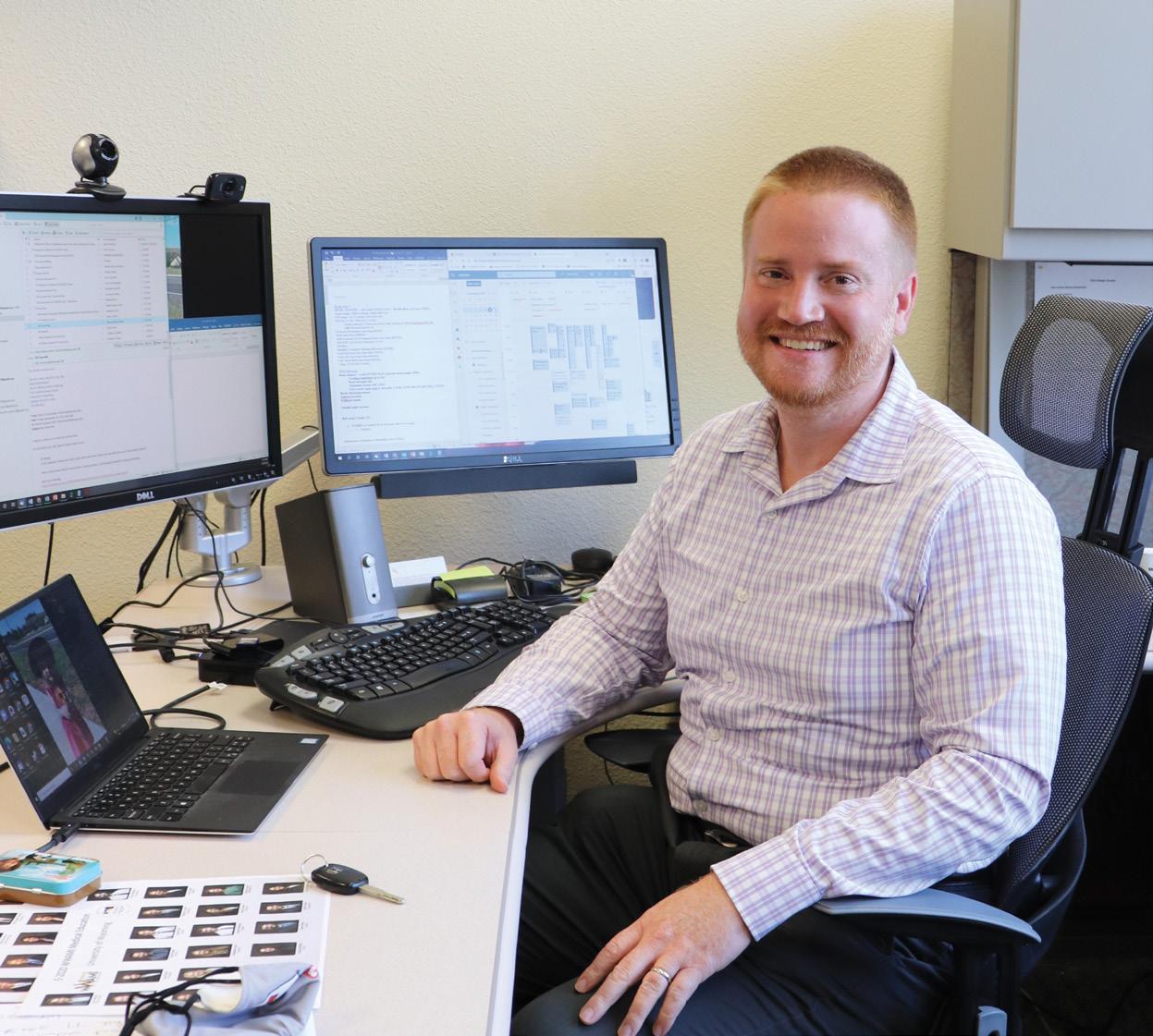
5 minute read
Putting Students to the Test
Professor, students aid Wyoming Public Health with COVID-19 testing
Dr. Brant Schumaker is no stranger to infectious diseases and pandemics. As an epidemiologist, veterinarian and director of WWAMI, the University of Wyoming’s medical education program, it’s what he studies for a living.
So, when the COVID-19 pandemic began, Schumaker was well equipped and prepared to meet the challenge. It’s his combined knowledge of animals and infectious diseases that allows him to have a wide understanding of COVID-19.
“COVID-19 is a zoonotic disease, which means it was started in animal populations. As a veterinarian, we’re trained from day one to look at disease on a multi-species level. We really buy into the concept of one health, which is the thought that the health of animals, humans and the environment are all interconnected,” he said.
In addition to his many roles, at the beginning of the pandemic Schumaker was also an associate professor in the Department of Veterinary Science. As irony would have it, Schumaker was teaching an epidemiology class when the pandemic started.
One of Schumaker’s former graduate students, who works for the Wyoming Department of Health’s laboratory, approached him and expressed a need for people to work in the lab short term to help with the increased volume of COVID-19 testing.
Ask anyone at the University of Wyoming, and they’ll tell you the institution prides itself on giving students real-world experience. While pandemics aren’t ideal, they do happen, and Schumaker’s epidemiology students were about to get the real-world experience of a lifetime.
“We more or less deployed our entire research lab to the Department of Health to help them with their testing efforts,” he said.
Schumaker collected data and helped prioritize sick patients’ samples while his students aided the Wyoming Department of Health’s public lab with COVID-19 testing for about three months. By the end of the semester and the students’ time at the lab, they had assisted with testing over 16,000 samples.
“You couldn’t ask for a more practical training experience in a real-world environment than being deployed to a pandemic,” Schumaker said. “It was extremely meaningful to watch our team be able to help in that capacity. I’m really proud of them.”
The students who helped with the COVID-19 testing efforts included Chris Anderson, Meagan Soehn, Kelsie Bowcutt, Samyr Wissar, Callie Klinghagen, Matios Indaylalu as well as UW alumni Taylor Fearing and Chayse Rowley.
“One of the best things about the University of Wyoming is the opportunity to include undergraduate students in practical real-world research and service. About half a dozen
of the students who worked on testing were undergraduate students,” Schumaker said.
Schumaker’s involvement with the COVID-19 pandemic far exceeds just the early stages—he’s also been involved with vaccination rollouts in Albany County.
“A large collaborative team of people in Albany County worked together to get our community vaccinated. That included partners at Ivinson Memorial Hospital, the county Department of Health, faculty throughout the College of Health Sciences and myself,” he said.
Schumaker and those he collaborated with launched a mass vaccine site at the old armory building in Laramie, which has significant history when it comes to vaccinations.
“That was the same site used for distributing the polio vaccine about 50 years prior. The same site that was involved in a really important vaccination effort to eradicate polio in the United States was then also used for COVID-19, which was really exciting,” Schumaker said.
During the initial stages of the vaccine rollout, Schumaker placed individuals into vaccine tiers that were put together by the Wyoming Department of Health as well as spent time helping direct individuals at the vaccination site.
“Helping with the traffic of people at the vaccine clinic site was probably the most rewarding aspect of working on a pandemic. There was a real sense of community, and we were all going to be a part of putting the pandemic to rest,” he said. “My only regret is that not more people opted to participate in getting vaccinated.”
As for his involvement at the university, Schumaker played a role in advocating for policies to help reduce the spread of the virus, tracking UW’s case numbers and conducting student and faculty surveillance testing.
Needless to say, Schumaker’s work throughout the pandemic was widespread. Through his work, he has helped thousands upon thousands of individuals in the Wyoming community.
“The COVID-19 pandemic has basically been the epidemiologist Super Bowl,” he said. “I felt really strongly called to serve out a sense of civic responsibility to help in any way I could for the pandemic response.”
Although many may feel the pandemic is over and done, Schumaker cautions that we’re not quite in the clear yet. The spikes in COVID-19 cases the United States and Wyoming are seeing are a direct result of vaccine hesitancy, he said.
“There is no single tool that is more effective at preventing severe disease and hospitalization from COVID-19 than getting vaccinated,” he said. “All of our living presidents, nearly 100% of all senators and congressmen, all Republican and Democratic governors have chosen to be vaccinated. It is the best tool that we have to protect our society and those among us who are not well enough or old enough to be vaccinated.”
Working as an epidemiologist during a global pandemic is a stressful job, to say the least. However, Schumaker feels a sense of pride and purpose in his work to keep the community safe and healthy.
“I would say that I’m probably too close to the pandemic right now to be overly reflective because we’re still in it, but I think it will be one of the more meaningful events in my life once it is truly over,” he said.
PHOTO BY JULIE SHELDON
Brant Schumaker—epidemiologist, veterinarian and director of WWAMI— and his students continue to collaborate with the Wyoming Department of Health during the COVID-19 pandemic.






